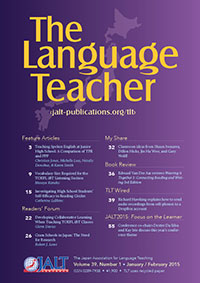Reading Time: 6 minutes
Part 1: The Future of English Motivation in a Global World
The International Symposium held at the University of Toyama on February 19th 2017 was an event which brought together not only many prestigious speakers, but also attendees whose own research has made a valuable contribution to the area. As such, the conference was both accessible and yet well-informed and insightful, with many lively and active discussions both during and between sessions.
In particular, the morning session saw a special seminar with Ema Ushioda, entitled The Future of English Motivation in a Global World, in which she talked through many of the issues that are addressed in a forthcoming issue of the Modern Language Journal, co-edited by Ema and Zoltan Dornyei and due to be published in 2017: 101(3). In particular, this special issue looks at the motivation to learn languages other than English. Ema’s special seminar sought to examine the role of English in a multilingual world, which began by drawing and expanding on Graddol’s book English Next (2006). Graddol talks about the ‘new orthodoxy’ of English, which implies the disappearance of English as a Foreign Language (EFL) as English becomes more and more a ‘life skill’. Instead of EFL, English instruction will become more integrated into educational systems around the world, particularly in the form of Content and Language Integrated Learning (CLIL) and English as a Medium of Instruction (EMI). English becomes part of the curriculum, not as a foreign language but as a method of instruction in and of itself. In other words, the ‘new orthodoxy’. Graddol’s book is well-known now, having been published just over ten years ago, and already there is much evidence that his predictions are coming to light. However, (as Ema says, there is always a ‘but’), there is also a very visible multilingual turn in Applied Linguistics, which perhaps rode on the waves of the social turn. In other words, a move away from psycholinguistic, cognitive and monolingual approaches to language. Much of early Second Language Acquisition (SLA) research focused on what has often been termed the ‘deficit’ view of L2 learning. Such a view posits that our L2 will never be as good as our L1, and thus implies that L1 users are ‘better’, which leads to the adoption of native-like norms for setting the ‘standard’. Such a view has been criticised in many different ways, not only because the reality of a native-speaker is based on a myth (Davies, 2003), but also because it leads to a range of practices within ELT that disadvantage the majority of English speaker/users in the world (Braine, 2010; Holliday, 2005; Lowe & Pinner, 2016; Medgyes, 1994; Reves & Medgyes, 1994; Swann, Aboshiha, & Holliday, 2015).

Ema also discussed the fact that the mounting pressure to learn English has actually been shown to damage the motivation to learn other languages (Dörnyei & Ushioda, 2011). This is deeply entwined with an ‘instrumentalist view’ of language education. In other words, we learn English for the purposes of acquiring greater access to social and cultural capital. We need it, want it, know it will make our lives better. And yet, as this places great pressure on us to learn the language, it de-emphasises other languages and ‘non-standard’ varieties, and it may also inhibit personal autonomy to learn English. At this point in her seminar, I wanted to raise my hand and tell Ema that you could almost say that English becomes a ‘disembodied language’, a point I have often made when examining the idea of Global English in relation to authenticity (Pinner, 2016). In fact, in her talk Ema was mainly talking about motivation and autonomy, yet for me I felt there was a great deal of overlap here with the concept of authenticity as well. As I have discussed in my doctoral research, authenticity, autonomy and motivation seem to form a dynamic triad (Pinner, 2017). Of course, Ema knows all about this, as she is my supervisor, but her talk was already very ‘meta’ and mapping the complexities and intricacies of the global position of English as a ‘world auxiliary language’ (Lo Bianco, 2014) to her own, much more personal, individual and contextually-based approach to motivation and autonomy (Ushioda, 2011a, 2011b, 2015, 2016).
Ema pointed out that such an instrumentalist view of learning is not, in fact, unique to languages but a worrying trend that can be seen throughout education. Ema talked about the new Teaching Excellence Review to be put in place in the UK next year, in which one of the assessment criteria are graduate employment rates. This highlights the fact that education is often seen as a means to an end; there is a utilitarian focus which downplays the humanitarian role of education. Fostering individuals with the capacity for critical thought is not the role of education as the government (and hence many institutions reliant on funding) see it. However, this view is more likely to be held by those who work as teachers. In other words, Ema’s special seminar highlighted the global dynamics, mixed-messages and socio-political agendas around English language education. She drew heavily on Lo Bianco (2014) notion of ‘domesticating the foreign’ to show how local and global policies entwine in the language classroom.
Fundamentally, Ema’s main point was that reaching native-like proficiency was not a realistic or meaningful goal for many learners in global contexts. The affordance of English for gaining social capital is important, but similarly with the world moving more toward super-diversity, English educational models would be better served if they were to highlight a multiple competencies approach to learning. Another aspect is that learning should be made personally meaningful, and people should learn to speak as themselves.
Although I fundamentally agree that the native-speaker model is a serious problem for English language instruction and that it has led to the disadvantaging of the majority of English speakers, it may also lead to other forms of discrimination as a result of the entangled ideologies at work in the world. In many ways, it boils down to social and cultural capital. People make judgements about us based on how we speak; and thus it may be disadvantageous for students to focus on learning English that could be seen as deviant, especially if this makes them hard to comprehend. This argument has been made many times; it is the crux of the Kachru-Quirk argument, and also the central justifications between Jenkins’ Lingua Franca core (2000). Also, the issue of language tests (which are based on ‘standard’ notions of the language) are another obstacle.
However, I don’t think that Ema was advocating that we encourage learners to speak in a way which is incomprehensible (although this argument was voiced during the Q&A). I think rather that Ema was promoting the same idea that she put forward in her persons-in-context relational view of motivation (Ushioda, 2009), which resonates with van Lier (1996) call for awareness, autonomy and authenticity as part of the interactions in the language classroom, both of which imply sociocultural approaches to learning and ecological perspectives to language. The key is that a person does not need perfect English, and it is important for students to have realistic goals about themselves and the levels of proficiency they actually need. This has been discussed in very interesting studies by Matsuda (2011) and Kubota (2013), both of whom found that Japanese learners might do well to assess their own goals in relation to what they need to achieve with the language, rather than aspiring to be simply ‘like native speakers’.
Overall, the talk was fascinating and gave me a lot of food for thought. In the next post, I will discuss Ema’s Keynote speech which discussed whether teachers should see themselves as motivators.
References
Braine, G. (2010). Nonnative Speaker English Teachers: Research, Pedagogy, and Professional Growth. London: Routledge.
Davies, A. (2003). The Native Speaker: Myth and reality (2nd ed.). Clevedon: Multilingual Matters.
Dörnyei, Z., & Ushioda, E. (2011). Teaching and researching: Motivation (2nd ed.). Harlow: Longman Pearson.
Graddol, D. (2006). English next : why global English may mean the end of ‘English as a foreign language’. London: British Council.
Holliday, A. (2005). The struggle to teach English as an international language. Cambridge: Cambridge University Press.
Jenkins, J. (2000). The phonology of English as an international language: New models, new norms, new goals. Oxford: Oxford University Press.
Kubota, R. (2013). ‘Language is only a tool’: Japanese expatriates working in China and implications for language teaching. Multilingual Education, 3(1), 1-20.
Lo Bianco, J. (2014). Domesticating the Foreign: Globalization’s Effects on the Place/s of Languages. The Modern Language Journal, 98(1), 312-325.
Lowe, R., & Pinner, R. (2016). Finding the Connections Between Native-speakerism and Authenticity. Applied Linguistics Review, 7(1), 27-52. doi:10.1515/applirev-2016-0002
Matsuda, A. (2011). ‘Not everyone can be a star’: Student’s and Teacher’s beliefs about English teaching in Japan. In P. Seargeant (Ed.), English in Japan in the era of globalization (pp. 38-59). Basingstoke: Palgrave Macmillan.
Medgyes, P. (1994). The non-native teacher (Revised ed.). London: Macmillan.
Pinner, R. S. (2016). Reconceptualising Authenticity for English as a Global Language. Bristol: Multilingual Matters.
Pinner, R. S. (2017). Social Authentication and the synergies between teacher and student motivation: an Autoethnographic inquiry into the interaction between authenticity and motivation in English language teaching at a Japanese university. (PhD Doctoral Thesis), University of Warwick, Warwick.
Reves, T., & Medgyes, P. (1994). The non-native English speaking EFL/ESL teacher’s self-image: An international survey. System, 22(3), 353-367.
Swann, A., Aboshiha, P., & Holliday, A. (Eds.). (2015). (En)Countering Native-Speakerism: Global Perspectives. Basingstoke: Palgrave Macmillan.
Ushioda, E. (2009). A person-in-context relational view of emergent motivation, self and identity. In E. Ushioda & Z. Dörnyei (Eds.), Motivation, language identity and the L2 self (pp. 215-228). Bristol: Multilingual Matters.
Ushioda, E. (2011a). Language learning motivation, self and identity: current theoretical perspectives. Computer Assisted Language Learning, 24(3), 199-210. doi:10.1080/09588221.2010.538701
Ushioda, E. (2011b). Motivating learners to speak as themselves. In G. Murray, X. Gao, & T. E. Lamb (Eds.), Identity, motivation and autonomy in language learning (pp. 11 – 25). Bristol: Multilingual Matters.
Ushioda, E. (2015). Context and complex dynamic systems theory. In Z. Dörnyei, P. MacIntyre, & A. Henry (Eds.), Motivational dynamics in language learning (pp. 47 – 54). Bristol: Multilingual Matters.
Ushioda, E. (2016). Language learning motivation through a small lens: A research agenda. Language Teaching, 49(4), 564-577. doi:10.1017/S0261444816000173
van Lier, L. (1996). Interaction in the language curriculum: Awareness, autonomy and authenticity. London: Longman.

















